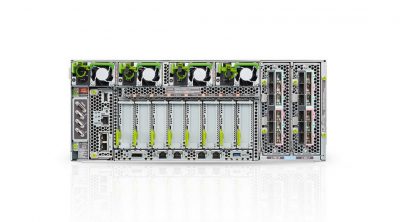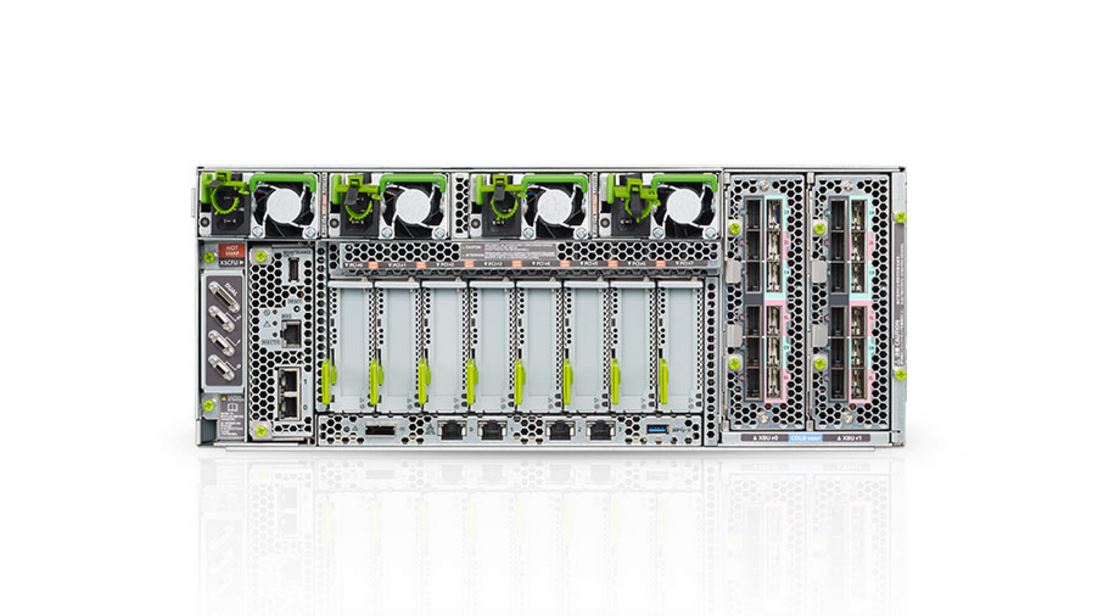Today we have the launch of the SPARC64 XII based Fujitsu SPARC M12 servers. While much of the vast majority of the server market, by volume, has moved to x86 architectures, the SPARC line of RISC CPUs is still alive with new systems. The Oracle Fujitsu SPARC M12 servers boast the newest SPARC64 chip, the SPARC64 XII can run at 4.25GHz with 12 cores. With the Fujitsu SPARC M12-2S you can scale up to 32 processors and 384 cores with up to 32TB of DDR4 memory. Aside from those features, the SPARC64 XII chips have RAS features as well as hardware accelerators for database applications.
Fujitsu SPARC M12 Servers
We found this video which should make most Oracle DBA’s drool (and wish they had a larger budget):
From the Oracle Press Release
Here is an excerpt from the Oracle release on the launch.

Features of the Fujitsu SPARC M12
- Supporting customers’ digital transformation by providing high-speed processing
Performance per CPU core is a significant measure to consider when increasing data processing efficiency, and Fujitsu SPARC M12 servers offer up to 2.5 times better core performance compared to the previous Fujitsu M10 models. The Fujitsu-developed SPARC64 XII processor, with the world’s highest per core performance, maximizes processing capability in mission-critical systems and databases without increasing server complexity, contributing to the optimization of customer IT investments. - Software on Chip, a feature carried on from the Fujitsu M10, accelerates database processing by leveraging the fact that use of in-memory databases for processing large volumes of data has been very effective in the cloud, expanding the number of simultaneous searches to twice that of the Fujitsu M10 when processing with Oracle Database In-Memory. The Fujitsu SPARC M12, which can dramatically accelerate a wide range of data processing, supports the digital transformations of customers by improving the efficiency of mission-critical systems, speeding up decision-making using big data, and improving customer services through multilateral information analyses.
- Stable operations with industry-first, new cooling technology
Fujitsu cutting-edge IT expertise has been used to develop Vapor and Liquid Loop Cooling (VLLC) technology. This industry-first cooling technology reliably cools the interior of the server through the phase change of liquid to vapor, roughly doubling cooling efficiency, and enabling safe and stable operations when building a private cloud environment with multiple Fujitsu SPARC M12 servers installed in a data center. - Optimized operations and management costs suited for business growth
Fujitsu SPARC M12 servers provide CPU Core Activation functionality, for configuring CPU resources one core at a time from a minimum of just two cores per server. CPU Core Activation allows servers to be configured to meet business needs, with the dynamic flexibility to grow as needed. - The high-end Fujitsu SPARC M12-2S model offers additional scalability in the form of building block architecture to connect additional Fujitsu SPARC M12-2S server chassis to form flexible scale-up and scale-out servers. By connecting a maximum of 16 building blocks, a single system with over 3,000 CPU threads can be created. Fujitsu SPARC M12-2S servers provide an ideal foundation for private cloud implementations by mitigating initial investment risks while allowing for gradual expansion.
- Supporting business continuity with stable system operation
Building on the Fujitsu mainframe heritage and the trusted RAS features found in Fujitsu M10 servers, Fujitsu SPARC M12 servers provide error detection and recovery mechanisms for error protection across all processor circuits, supporting stable operation of mission-critical processing.





Funny they mention “the cloud”, you hardly get anything other than x86 with cloud service providers, I doubt you can even get it on Oracles offering.
IIRC Oracle prepares something like SPARC-based cloud offering.
How much would it cost to run oracle database on that ????
LOL @ Larry
Actually it may be price-competitive with Intel due to various Oracle price/ratio manipulations. Certainly it’ll be cheaper than POWER :-)
BTW, I’m very surprised that Fujitsu came with new SPARC64. I’ll need to find out more details but even this simple fact is quite amusing in the shrinking market they are living with their offering in. From description it looks like they caught Oracle with their DB/security features at least, which is also quite an achievement IMHO… Kudos to Fujitsu.
It is true that x86 is the large majority of servers. However, until recently, the largest x86 servers had 8-sockets delivered by HP, Oracle, etc. Just recently, large 16-socket or even 32-socket x86 servers has just arrived (HP Kraken which is a redesigned Unix Superdome, and SGI UV300H). The large SGI UV3000 servers are clusters with 10.000s of cores, capable of only running HPC number crunching workloads. If you want to run business workloads, such as SAP, large databases, etc – you need a large scale up server. And these business servers maxes out at 16- or even 32-sockets. If you look at the SAP benchmarks, the largest servers are 32-sockets. There are no 10.000 core clusters such as SGI there. Clusters can not run business workloads.
So, for large business workloads, such as SAP, databases, etc – you must go to a large scale-up server with 16 or 32 sockets. And that market belongs exclusively to Mainframes and Unix RISC servers. Just recently 16-socket business servers x86 have arrived but I have not seen any benchmarks yet. Probably the performance is quite bad as they are the first generation. It takes a couple of decades before you get good scalability. RISC and Mainframes have done scaling to 16 and 32 sockets for decades. I expect the first ten years, x86 servers will lag behind seriously in performance and RAS. And if we look at the offifcial SPARC M7 cpu benchmarks, it is typically 2-3x faster than the fastest x86 cpu and POWER8 cpu. This Fujitsu SPARC M12 is almost as fast as the SPARC M7 cpu in general. This means that large 16 or 32-socket x86 servers will have a hard time catching up in the Enterprise busines arena – which belongs to RISC and Mainframes. First, x86 scales bad. Second, x86 is way slower than RISC. So I doubt x86 will threaten RISC and Mainframes in the large business server arena. There are no fast SAP benchamrks, neither fast TPC database benchmarks.